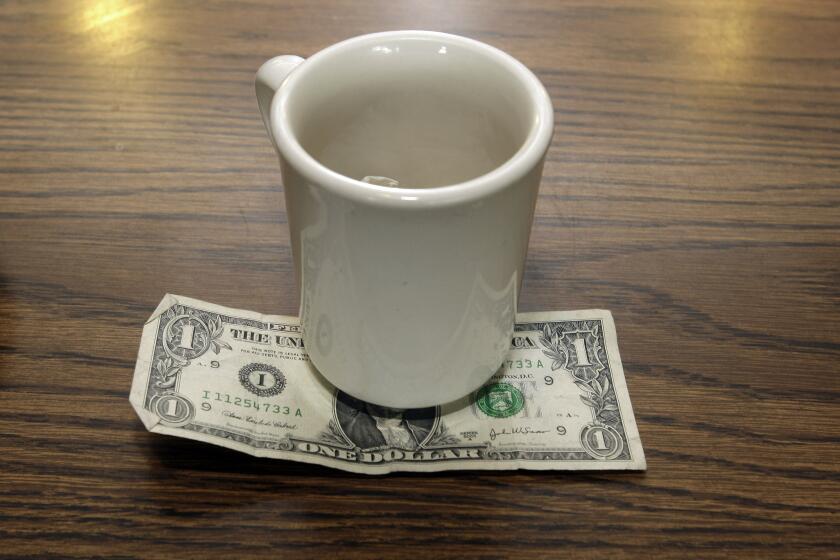<i> Sous-vide </i>cooking gives chefs an option
Cooking food in a warm-water bath can be done at home in a picnic cooler.
- Share via
» Sous-vide cooking gives chefs an option
Cooking food in a warm-water bath can be done at home in a picnic cooler.
Sous-vide cooking is one of the most important new tools to enter the restaurant kitchen in the last 100 years, but because of the expensive equipment required, until now it's been out of reach of most home cooks. But if you have heavy-duty plastic wrap, a big cooler chest and an accurate probe thermometer, you can try it.
Sous-vide technology has taken hold in modern restaurant kitchens because it is based on a simple and fundamental idea: precision cooking of foods at carefully selected temperatures for precise lengths of time.
Most of the time in the kitchen, there is a great difference between the temperature at which we're cooking the food and the desired final temperature of that food. We may want a piece of lamb to be perfectly medium-rare at 139 degrees, but we cook it in a 400-degree oven. The result is vastly different degrees of doneness between the surface of the meat and its center. Furthermore, because the oven temperature is so high, if you leave in the lamb for too long, it will overcook.
With sous-vide, you cook food in a water bath that is at the desired final temperature of the meat. The water bath for that piece of lamb will be 139 degrees, so it will have exactly the same degree of doneness from the outer surface all the way to the center. Cooking this way also vastly reduces the likelihood that something will be overdone. As a bonus, cooking slowly in a tightly contained environment also helps food retain its natural juices and allows us to more effectively add flavorings.
While this accuracy can be liberating, I am always careful to emphasize — particularly with our young cooks who have had access to precision cooking for their entire careers — that sous-vide technology is not a replacement for traditional culinary knowledge. Rather, it is just another tool that educated cooks can add to their repertoires — even in the home kitchen.
In the professional kitchen, we cook sous-vide by encasing food in airtight plastic using chamber vacuum sealers (hence the name sous-vide, literally "under pressure") and then cooking them in precision-controlled water baths using a tool called an immersion circulator. Though these are now becoming available for home use, they are still quite expensive. But you can get similar results using equipment you probably have around the house. They won't seal quite as tightly or give you the exact temperature control of the professional equipment, but they will work quite well.
Rather than cooking the food using an immersion circulator, you can achieve similar results using a large picnic cooler and a probe thermometer.
Here's how you do it: Fill the cooler with hot tap water to preheat for 10 minutes and then drain. On the stove, bring water to the desired cooking temperature (you'll probably need to fill a couple of stockpots). Then transfer enough hot water to the cooler to fill it nearly to the top, reserving some water for later temperature adjustments.
Add the food and then check the temperature of the water and adjust as needed. If the temperature is too high, pour in a little cold water. If it's too low, add in some of the reserved hot. A good-sized, well-insulated picnic cooler with its lid on (we use a 28-quart picnic cooler) should maintain an even temperature for around one hour. For slightly longer cooking times, check the temperature periodically and adjust with fresh hot water as needed.
For even longer cooking times, you can use a pot of water on the stove, though it will be more challenging to control the temperature. If you do elect to cook on the stove top, keep in mind that a larger body of water will maintain a steadier temperature, so select a pot that is large enough for the meat you're cooking and an ample amount of liquid. Depending on how much control you have over the burners on your range, you may want to purchase a tool called a diffuser from your local kitchen store to provide separation between the pot and burner, making it easier to keep your water at a sufficiently low temperature.
Because cooking this way doesn't allow meat to get hot enough to brown, you can sear it on the stove either before or after cooking. The choice of which to use is up to you, but remember that anytime you want a crisp skin (such as with duck), it should definitely be seared afterward.
In place of the chamber vacuum sealer, you can get much the same result by simply wrapping the food very tightly in plastic wrap, or sealing it in a food storage bag. Whichever you choose, be sure that the plastic wrap or bag is certified food-safe well above the temperature at which you'll be cooking.
Always remember the absolute importance of time and temperature. The times and temperatures used in these recipes are accurate based on the size and cuts of meat called for. Particularly when rolling food in plastic, the diameter of the finished cylinder will be the deciding factor in the time, but for temperature you can rely on a variety of printed and online resources.
Such guidance will give you an excellent starting point, but determining the ideal intersection of time and temperature for any recipe will always remain the responsibility of you, the chef.
Eat your way across L.A.
Get our weekly Tasting Notes newsletter for reviews, news and more.
You may occasionally receive promotional content from the Los Angeles Times.









